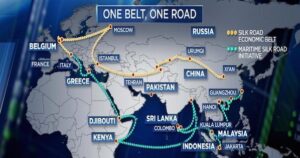 Moon Desk: The enhancement of geographical linkages has improved road, rail and air transportation systems. It is envisaged that frequent and free exchanges of growth and people-to-people contact, enhancing understanding through academic, cultural and regional knowledge forms the basis of connectivity. In this context, whenever we discuss CPEC, we refer to energy, road, infrastructure development, connectivity and interdependence.
Moon Desk: The enhancement of geographical linkages has improved road, rail and air transportation systems. It is envisaged that frequent and free exchanges of growth and people-to-people contact, enhancing understanding through academic, cultural and regional knowledge forms the basis of connectivity. In this context, whenever we discuss CPEC, we refer to energy, road, infrastructure development, connectivity and interdependence.
While contextualizing the CEPC, it is agreed that it provides a great platform for both China and Pakistan to promote bilateral and regional trade. The project connecting Gwadar Port with Xinjiang Province in Western China, is dubbed as the “corridor of opportunity”, and will give China open access to South Asia, the Indian Ocean and beyond. Gwadar Port, being developed as part of the CPEC project, will act as a catalyst for bridging gaps in the Chinese supply chain, energy supplies and its trade connectivity with the region.
It is important to highlight the maritime component of CPEC which connects Gwadar with other ports, continents and their commercial markets. The CPEC is closely affiliated with the implementation of the Belt and Road Initiative (BRI) or the ‘New Silk Road’. Therefore, for better understanding of sea routes, integral to CPEC, a quick overview of BRI is considered important.
As a multi-billion dollar ‘connectivity initiative’ led by China, the BRI is an ambitious effort, with trans-continental dimensions – aimed at improving infrastructure and industrialization. The project aims to increase connectivity within Asia, Europe, the Middle East and Africa -via land (the belt) and sea (the road) and therefore known as a catalyst for economic growth, social development and regional cooperation. The project has so far two member states and territories that will be directly beneficial for Afghanistan as well as CARs are also in the negotiation process.
The BRI initiative thus refers to two large-scale development proposals: the land-based ‘Silk Route Economic Belt’ (SREB) and the sea-based ’21st Century Maritime Silk Road” (CMSR). The BRI focuses on infrastructural development, economic cooperation and other connectivity projects aimed at linking maritime components with the land spread over six Corridors, including the 7th one between China and Myanmar. Firstly, the Northern Corridor connects China with Europe by land via Russia. Secondly, the Central Corridor focuses on infrastructure build-up between China and Europe via Iran and Turkey by both land and sea.
Thirdly, the Southern Corridor, which aims to connect Kashgar in China’s Xinjiang province with Pakistan’s sea ports in the South (particularly Gwadar). Besides these three major corridor initiatives, the implementation of four other corridors is currently being developed by Beijing that are China-Mongolia-Russia Corridor, China-Myanmar-Bangladesh-India Corridor, China-Southeast Asia Mainland Corridor (CSEMC) and China-Myanmar Economic Corridor (CMEC).
CPEC is not limited to two countries; it can easily include other countries and international partners for future development. Its design/strategic construct allows all regional and extra- regional parties to equally benefit from it. CPEC’s true potential is critically dependent on its connectivity and maintaining a maritime bridge with Arabian Pennsylvania African continent, island nations of IOR and Far East.
Thus CPEC will provide access to landlocked countries like Afghanistan and CARs, Russia and China through Gwadar port. This connectivity is the maritime component, is needs a focused attention by both China and Pakistan.
It is believed that through improved infrastructure, transport connectivity and true realization of interdependence, the goals of regional integration will be achieved amongst the CPEC participating states. There is no doubt that trade and economic interdependence though CPEC will bring peace, prosperity and enhance cooperation. The countries not joining CPEC will be lagging behind in regional development.





